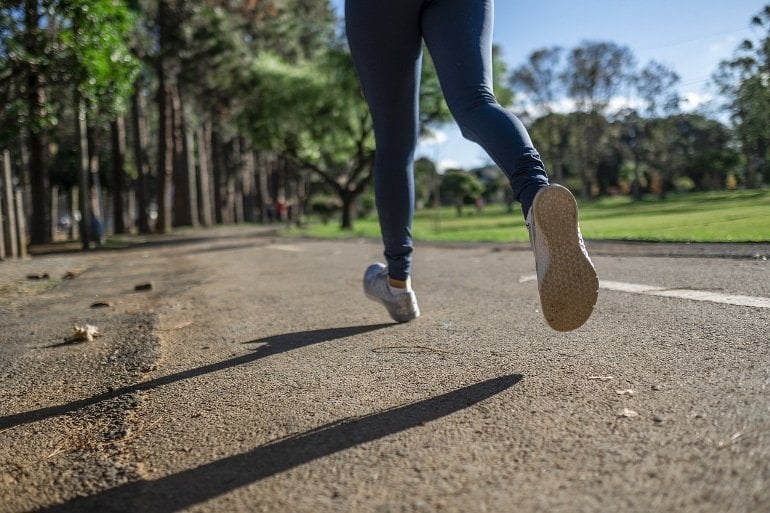Summary: Exercise helps to improve the severity of the movement-related symptoms and the overall well-being of those suffering from Parkinson’s disease.
Source: Cochrane
Physical exercise can help to improve the severity of movement-related symptoms and the quality of life in people with Parkinson’s Disease. Findings from the first Cochrane review of the available evidence found that any type of structured exercise is better than none.
The review looked at 156 randomized controlled trials comparing physical exercise with no physical exercise or with different types of exercise, and it included a total of 7,939 people from around the world, making it the largest and most comprehensive systematic review to study the effects of physical exercise in people with Parkinson’s Disease.
The review from Cochrane, a collaboration of independent, international experts, was led by Dr Elke Kalbe, Professor of Medical Psychology at the University of Cologne, Germany.
It found that physical exercise ranging from dance, water-based exercise, strength and resistance exercise and endurance exercise, to tai chi, yoga and physiotherapy, made mild to large improvements to the severity of movement-related (‘motor’) symptoms and quality of life.
“Parkinson’s Disease is a progressive disorder of the nervous system that mostly affects people over 60,” said Professor Kalbe. “Symptoms begin gradually and include movement problems such as trembling, stiffness, slowness of movement and balance, and lack of coordination. People can also have emotional and mood problems, fatigue, sleep problems and cognitive difficulties.
“Parkinson’s Disease cannot be cured, but the symptoms can be relieved, and physiotherapy or other forms of exercise may help too. Until now it has been unclear whether some types of exercise work better than others. We wanted to find out what exercise works best to improve movement and quality of life.”
The average age of the participants in the studies included in the review was between 60 and 74 years. Most had mild to moderate disease and no major impairment of their thinking processes. The review found that most types of exercise worked well for the participants compared to no physical exercise.
The first author of the review, Mr Moritz Ernst, is a member of Cochrane Haematology and deputy head of the working group on Evidence-based Medicine, which is led by co-author of the study, Professor Nicole Skoetz, at University Hospital Cologne.
He said: “We observed clinically meaningful improvements in the severity of motor symptoms for most types of exercise. These included dancing, training to improve gait, balance and movement, multi-exercise training, and mind-body training.
“We saw similar benefits in the severity of motor symptoms for water-based training, strength and resistance training, and endurance training, but the estimates of improvement were rather imprecise, meaning that we are not as confident in saying that these improvements are clinically meaningful.
“For the effects on quality of life, we observed clinically meaningful beneficial effects for water-based training, and effects that are probably clinically meaningful for several types of exercise, such as endurance training, mind-body training, training to improve gait, balance and movement and multi-exercise training. Again, these estimates were rather imprecise.”
The certainty in the estimates for the effects on symptoms from different forms of exercise varied because some studies were very small, and not all provided information on the severity of motor symptoms and quality of life for all the participants. However, the authors say that their review highlights that most types of exercise produced meaningful improvements, and they found little evidence of much difference between different exercises.

Prof. Kalbe said: “We think that our results are good news because they indicate that people with Parkinson’s Disease can benefit from various structured exercise programmes to improve the severity of motor symptoms and quality of life. Our review highlights the importance of physical exercise in general, while the exact exercise type may be secondary.
“Therefore, the personal preferences of people with Parkinson’s Disease should be given special consideration to help motivate them to adhere to an exercise programme. Any exercise counts!
“It is important to point out that our conclusions do not rule out that certain motor symptoms may be treated most effectively by programmes, such as physiotherapy, that are designed specifically for people with Parkinson’s disease.”
Mr Ernst concluded: “Although our results are quite promising for people with Parkinson’s Disease, the certainty in the evidence on the efficacy of different exercise types and on potential differences between them, was usually limited. This was also because most studies had a very small sample size.
“Therefore, although there is already a large amount of research in this field, we would encourage researchers to conduct larger studies with clearly defined samples, as this would help to draw conclusions with more confidence.
“In addition, it would be admirable to see studies that focus on people with more advanced disease and thinking impairment, so that we could find out if physical exercise could also be beneficial for these people.”
About this Parkinson’s disease and exercise research news
Author: Press Office
Source: Cochrane
Contact: Press Office – Cochrane
Image: The image is in the public domain
Original Research: Open access.
“Physical exercise for people with Parkinson’s disease: a systematic review and network meta‐analysis” by Moritz Ernst et al. Cochrane Database of Systematic Reviews
Abstract
Physical exercise for people with Parkinson’s disease: a systematic review and network meta‐analysis
Background
Physical exercise is effective in managing Parkinson’s disease (PD), but the relative benefit of different exercise types remains unclear.
Objectives
To compare the effects of different types of physical exercise in adults with PD on the severity of motor signs, quality of life (QoL), and the occurrence of adverse events, and to generate a clinically meaningful treatment ranking using network meta‐analyses (NMAs).
Search methods
An experienced information specialist performed a systematic search for relevant articles in CENTRAL, MEDLINE, Embase, and five other databases to 17 May 2021. We also searched trial registries, conference proceedings, and reference lists of identified studies up to this date.
Selection criteria
We included randomized controlled trials (RCTs) comparing one type of physical exercise for adults with PD to another type of exercise, a control group, or both.
Data collection and analysis
Two review authors independently extracted data. A third author was involved in case of disagreements.
We categorized the interventions and analyzed their effects on the severity of motor signs, QoL, freezing of gait, and functional mobility and balance up to six weeks after the intervention using NMAs. Two review authors independently assessed the risk of bias using the risk of bias 2 (RoB 2) tool and rated the confidence in the evidence using the CINeMA approach for results on the severity of motor signs and QoL. We consulted a third review author to resolve any disagreements.
Due to heterogeneous reporting of adverse events, we summarized safety data narratively and rated our confidence in the evidence using the GRADE approach.
Main results
We included 156 RCTs with a total of 7939 participants with mostly mild to moderate disease and no major cognitive impairment. The number of participants per study was small (mean 51, range from 10 to 474). The NMAs on the severity of motor signs and QoL included data from 71 (3196 participants), and 55 (3283 participants) trials, respectively. Eighty‐five studies (5192 participants) provided safety data. Here, we present the main results.
We observed evidence of beneficial effects for most types of physical exercise included in our review compared to a passive control group. The effects on the severity of motor signs and QoL are expressed as scores on the motor scale of the Unified Parkinson Disease Rating Scale (UPDRS‐M) and the Parkinson’s Disease Questionnaire 39 (PDQ‐39), respectively. For both scales, higher scores denote higher symptom burden. Therefore, negative estimates reflect improvement (minimum clinically important difference: ‐2.5 for UPDRS‐M and ‐4.72 for PDQ‐39).
Severity of motor signs
The evidence from the NMA (71 studies; 3196 participants) suggests that dance has a moderate beneficial effect on the severity of motor signs (mean difference (MD) ‐10.32, 95% confidence interval (CI) ‐15.54 to ‐4.96; high confidence), and aqua‐based, gait/balance/functional, and multi‐domain training might have a moderate beneficial effect on the severity of motor signs (aqua‐based: MD ‐7.77, 95% CI ‐13.27 to ‐2.28; gait/balance/functional: MD ‐7.37, 95% CI ‐11.39 to ‐3.35; multi‐domain: MD ‐6.97, 95% CI ‐10.32 to ‐3.62; low confidence). The evidence also suggests that mind‐body training and endurance training might have a small beneficial effect on the severity of motor signs (mind‐body: MD ‐6.57, 95% CI ‐10.18 to ‐2.81; endurance: MD ‐6.43, 95% CI ‐10.72 to ‐2.28; low confidence). Flexibility training might have a trivial or no effect on the severity of motor signs (MD 2.01, 95% CI ‐4.82 to 8.98; low confidence). The evidence is very uncertain about the effects of strength/resistance training and “Lee Silverman Voice training BIG” (LSVT BIG) on the severity of motor signs (strength/resistance: MD ‐6.97, 95% CI ‐11.93 to ‐2.01; LSVT BIG: MD ‐5.49, 95% CI ‐14.74 to 3.62; very low confidence).
Quality of life
The evidence from the NMA (55 studies; 3283 participants) suggests that aqua‐based training probably has a large beneficial effect on QoL (MD ‐14.98, 95% CI ‐23.26 to ‐6.52; moderate confidence). The evidence also suggests that endurance training might have a moderate beneficial effect, and that gait/balance/functional and multi‐domain training might have a small beneficial effect on QoL (endurance: MD ‐9.16, 95% CI ‐15.68 to ‐2.82; gait/balance/functional: MD ‐5.64, 95% CI ‐10.04 to ‐1.23; multi‐domain: MD ‐5.29, 95% CI ‐9.34 to ‐1.06; low confidence). The evidence is very uncertain about the effects of mind‐body training, gaming, strength/resistance training, dance, LSVT BIG, and flexibility training on QoL (mind‐body: MD ‐8.81, 95% CI ‐14.62 to ‐3.00; gaming: MD ‐7.05, 95% CI ‐18.50 to 4.41; strength/resistance: MD ‐6.34, 95% CI ‐12.33 to ‐0.35; dance: MD ‐4.05, 95% CI ‐11.28 to 3.00; LSVT BIG: MD 2.29, 95% CI ‐16.03 to 20.44; flexibility: MD 1.23, 95% CI ‐11.45 to 13.92; very low confidence).
Adverse events
Only 85 studies (5192 participants) provided some kind of safety data, mostly only for the intervention groups. No adverse events (AEs) occurred in 40 studies and no serious AEs occurred in four studies. AEs occurred in 28 studies. The most frequently reported events were falls (18 studies) and pain (10 studies). The evidence is very uncertain about the effect of physical exercise on the risk of adverse events (very low confidence).
Across outcomes, we observed little evidence of differences between exercise types.
Authors’ conclusions
We found evidence of beneficial effects on the severity of motor signs and QoL for most types of physical exercise for people with PD included in this review, but little evidence of differences between these interventions. Thus, our review highlights the importance of physical exercise regarding our primary outcomes severity of motor signs and QoL, while the exact exercise type might be secondary. Notably, this conclusion is consistent with the possibility that specific motor symptoms may be treated most effectively by PD‐specific programs. Although the evidence is very uncertain about the effect of exercise on the risk of adverse events, the interventions included in our review were described as relatively safe. Larger, well‐conducted studies are needed to increase confidence in the evidence. Additional studies recruiting people with advanced disease severity and cognitive impairment might help extend the generalizability of our findings to a broader range of people with PD.






